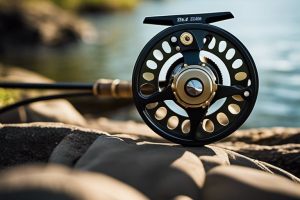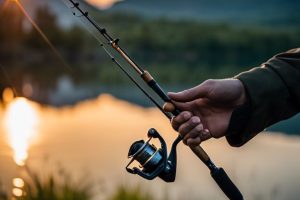Most anglers know that choosing the right fly reel can make or break your chances against aggressive predatory species. Selecting a reel that withstands the relentless power of fish like pike, musky, or tarpon is vital for your success. You’ll want to consider factors such as drag strength, line capacity, and construction material to ensure your gear stands up to the challenge. In this guide, you will discover what to look for in a fly reel that suits your needs when targeting these fierce ocean and freshwater predators.
Choosing the Right Fly Reel for Predatory Fish
Before you step onto the water, it’s necessary to understand that selecting a fly reel isn’t merely about aesthetics or brand loyalty. Your choice should reflect the specific characteristics of the predatory species you are targeting. Each species has evolved unique feeding strategies, strength, and habitat preferences, which in turn dictate the equipment you’ll need to secure a successful catch. Right reels can make all the difference between landing a prized fish or returning home empty-handed.
Considerations for Species-Specific Reels
Right now, you may be focusing on species like bass, pike, or even saltwater gamefish. Each of these predators has different demands. For example, if you are targeting larger species like pike, you’ll need a reel with a robust drag system and higher line capacity. Conversely, if you’re after smaller, fast-striking species like bass, a lighter, more agile setup is ideal. You must consider not only the species but the techniques you will employ, whether that’s stripping streamers or using poppers.
Key Features for Tackling Aggressive Fish
Key features when choosing a fly reel for aggressive fish will enhance your ability to make quick, decisive moves while casting or retrieving. Look for reels with lightweight materials that still offer durability, as well as designs that facilitate a smooth line retrieval under pressure. With aggressive strikes, your reel must be ready at a moment’s notice to accommodate the varied movements of the fish.
- Strong drag system: Essential to withstand sudden, forceful runs.
- High line retrieval rate: Allows for quick re-engagement after a strike.
- Durable construction: Able to endure abrasive environments—like saltwater or rocky streams.
- Corrosion resistance: Especially important if fishing in marine conditions.
- Large spool: Provides ample line capacity for long runs.
The right features will enhance your fishing experience as you challenge the fiercest predators in the water. Whether you’re stalking freshwater giants or pursuing saltwater titans, having gear that can keep up with your ambitions is paramount.
Fish species often show aggressive behavior, and your equipment must match that ferocity. When your quarry strikes, your reel should respond with the precision and strength needed to control the situation. Whether it’s a hefty river trout or an ocean predator, an effective reel will ensure you don’t lose a fish to a lack of responsiveness.
- Smooth clutch engagement: Prevents line tangles and backlashes.
- Dynamic braking systems: Helps in managing the initial run when a fish strikes.
- Lightweight design: Facilitates easy handling over long periods.
- Precise drag adjustment: Ensures you can fine-tune the resistance as needed.
- Ergonomic handle: Supports comfort during extended fights.
The key to a successful day on the water lies in your preparation and understanding of how your gear can meet the challenges of predatory fish.
Reel Size and Capacity
It is crucial to select the right reel size when you aim to target aggressive, predatory species. The size of your reel directly correlates to the type of fish you plan to catch. Larger predatory fish such as pike, muskie, and tarpon require reels that can handle heavier lines and more backing. When you choose a reel, consider the size of your target species. A reel that is too small may lead to line failures or unexpected break-offs. You need a reel capable of withstanding the tough battles that come with landing these formidable fish.
Matching Reel Size to Fish Size
Size matters in fishing. Matching your reel to the species you are targeting is vital for success. For instance, if you are after a large saltwater fish like tuna, you should opt for a larger reel that offers a robust drag system and ample line capacity. Conversely, if your target is a smaller freshwater species like bass, a medium-sized reel will suffice. Understanding the average size of the fish in your chosen location can help you make an informed decision, ensuring you don’t find yourself underprepared when that big one strikes.
Line Capacity and Backup Systems
Systems designed to hold adequate line capacity are vital when targeting aggressive species. Your reel should have enough capacity to accommodate at least 150-300 yards of backing, depending on the fish size and fishing conditions. This not only prevents line spills but also provides you with a reliable backup should the fish take a long run. Knowledge of the species you’re after and their behavior patterns can aid in calculating the appropriate line capacity you’ll need. A well-sized reel, combined with a proper setup, will increase your chances of successfully landing those hard-fighting fish.
With increased line capacity, you gain confidence and performance flexibility, vital for battling strong fish. Having sufficient backup systems safeguards against the unexpected. Aggressive predatory species are known for their sudden bursts of speed and acrobatic displays, which often lead to long runs. When targeting these species, make sure your reel is outfitted with the right line and enough capacity to accommodate those exhilarating fights. This foundation will ensure that you are ready for whatever the fishing day throws your way.
Drag Systems for Predatory Fish
Assuming you’re preparing to target aggressive predatory species, you must pay special attention to the drag system of your fly reel. This component can mean the difference between landing a trophy fish and losing it mid-fight. Not all drag systems are created equal; each has its strengths and weaknesses. When searching for a reliable reel, consider checking out this advice to purchase a new fly fishing reel saltwater proof for guidance. The drag mechanism must be smooth and robust, efficiently controlling line tension and preventing break-offs in turbulent waters.
Types of Drag Systems: Mechanical vs. Hydraulic
To understand how to choose the right drag system for predatory fish, familiarize yourself with the two primary types: mechanical and hydraulic drag systems. Mechanical drag systems often use a series of washers and springs that engage when a fish pulls on the line. They are simple, reliable, and typically easier to adjust on the fly. In contrast, hydraulic drag systems employ a fluid-based mechanism, offering a more consistent and adjustable drag pressure that can reduce jerking movements when a fish runs. This smoothness is vital when fighting a powerful predator.
| Drag System | Characteristics |
|---|---|
| Mechanical | Simple, reliable, easily adjustable |
| Hydraulic | Smoother, better for prolonged fights |
| Construction | Metal or composite materials |
| Maintenance | Requires regular inspection |
| Cost | Varies significantly based on design |
- Simple design of mechanical drag systems
- Hydraulic systems offer smoother performance
- Choose materials wisely for durability
- Inspect and maintain regularly
- Budget adequately based on your needs
This is crucial for ensuring your reel operates effectively when battling powerful fish.
Setting the Right Drag Pressure
Types of drag pressure are critical when you are gearing up for a fight with predatory fish. You should consider the weight and species you are after as you set your drag. Too tight, and the fish can break your line or pull your rod from your hands. Too loose, and you risk losing them entirely as they make their escape. A good rule of thumb is to set your drag to approximately one-third of your tippet strength. This way, you can exert enough pressure to tire the fish without risking a snap.
Pressure management is crucial when engaging aggressive predators. While you might instinctively tighten your drag to stop a powerful run, consider the dynamics of each situation. Adjust your reel to account for the fish’s behavior and the environment you are in. A well-set drag allows you to balance between a relentless pursuit and a controlled fight. That balance can be the difference between a frayed line and a gratifying catch.
All things considered, understanding the nuances of drag systems will empower you during your fly fishing adventures. Whether choosing a mechanical or hydraulic reel, selecting the right drag pressure is vital for success with predatory species.
Materials and Durability
Now, when targeting aggressive predatory species, the materials and construction of your fly reel are crucial. The demands of both saltwater and freshwater environments require a reel designed to withstand severe conditions. Choosing a reel like the XO Fly Reel ensures you have a durable option that meets the rigors of your fishing adventures. A well-constructed reel not only stands up to the test of time but also provides you with the confidence to fight hard-fighting fish. Ensure your selected reel has a robust frame and spool that can handle high drag settings, as these fish often put your equipment through its paces.
Saltwater vs. Freshwater Reel Construction
The primary difference between saltwater and freshwater reel construction lies in the materials used. Saltwater reels typically incorporate anodized aluminum or high-grade composites, which are more resistant to the corrosive effects of saltwater. On the other hand, freshwater reels may utilize lighter materials that prioritize ease of handling and weight. Despite these differences, both reels must feature a solid design to ensure reliability when battling aggressive species.
In saltwater environments, you need a reel that can endure constant exposure to salt and moisture. This is where the significance of material choice becomes apparent. Freshwater reels should balance lightweight design with strength, allowing you to deploy and retrieve your line effortlessly. No matter the environment you choose to fish in, the durability of your reel will determine your success in landing aggressive fish.
Corrosion-Resistant Materials and Coatings
With the demands of fishing in various environments, corrosion-resistant materials and coatings are vital for the longevity of your reel. The best fly reels incorporate advanced materials and protective finishes that help prevent rust and deterioration. Look for anodized components and sealed drags, as these features enhance durability and performance, especially in saltwater conditions. Chemically treated surfaces or special coatings provide an extra layer of protection, extending the life of your fishing gear.
Reel manufacturers are now focusing on developing materials and coatings that resist corrosion while also providing strength. Innovations in chemistry have led to the creation of coated surfaces that can withstand not only saltwater exposure but also abrasion from pebbles and rocks found in freshwater bodies. By opting for reels crafted with corrosion-resistant materials, you ensure that your equipment will maintain its reliability, allowing you to focus on what truly matters—catching that elusive predatory fish.
Retrieval Rates and Speed
Despite the beauty of the water and the changing light, your focus should remain sharp when targeting predatory fish. Quick retrieval is crucial for these aggressive species, as they strike with speed and ferocity. When a bass, pike, or muskie makes its decision to hunt, it does so with a directness that leaves little room for hesitation. You need a reel that can keep up, allowing you to bring in your line swiftly to maintain tension, set the hook, and capitalize on that split-second opportunity.
Importance of Quick Retrieval for Predatory Fish
An effective retrieval system can make all the difference between a successful catch and an empty hook. Predatory fish, by their nature, are opportunistic feeders. They hunt actively, often chasing their prey at impressive speeds. When you present your fly—whether it’s mimicking a wounded baitfish or other enticing target—you must be ready to retrieve quickly to match their pace. A slow or clunky retrieval can result in missed opportunities and frustrated casts.
Gear Ratios and Retrieve Speeds
Importance of the gear ratio is often overlooked, yet it significantly impacts your fishing success. A higher gear ratio translates to faster line retrieval speed. For example, if you’re using a reel with a gear ratio of 6:1, you can reel in six inches of line for every revolution of the handle. This means you can retrieve your fly quickly after a cast, keeping it active in the strike zone longer and lessening the time spent with a slack line.
This ability to maintain an active, consistent retrieval is vital when targeting predatory species. Reels with gear ratios ranging from 6:1 to 8:1 are ideal for those who want an efficient and quick line recovery. Be mindful of, the right gear ratio not only enhances your reaction time but also gives you better control over the presentation. Choose wisely, for the speed of your retrieve might be just what you need to entice that trophy catch.
Balance and Ergonomics
Not all reels are created equal, especially when targeting aggressive predatory fish. The balance of your reel plays a crucial role in how effectively you can cast and retrieve. When the weight distribution is even, your rod feels lighter, allowing for longer casting distances and more precision. This is imperative when dealing with species that demand accuracy and quick reflexes, such as bass or pike. If your reel is too heavy on one side, you risk straining your wrist and decreasing your casting accuracy, making it harder to reach those prime fishing spots where the predator’s lurk.
Importance of Balanced Reels for Casting Accuracy
To ensure you don’t miss the perfect catch, consider the mechanics of casting. A balanced reel stabilizes your setup, allowing for smoother transitions during casts. When you can harness the full potential of your gear, targeting that trophy fish becomes significantly easier. The right balance reduces fatigue and enhances your ability to make quick adjustments, crucial when predatory fish strike swiftly and unexpectedly.
Ergonomic Design for Comfort and Control
Ergonomic design is vital for comfort and control during those long days on the water. A well-designed reel fits comfortably in your hand, allowing for better grip and easier maneuvering. This is particularly important when you’re fighting powerful fish that can put your equipment—and your endurance—to the test. Opting for reels with comfortable grips and user-friendly features can elevate your fishing experience, making each catch feel more rewarding.
Another key aspect of ergonomic design is the layout of the reel’s components. Buttons and handle placements should feel natural, allowing you to adjust settings swiftly without fumbling around. This seamless interaction with your gear not only enhances your control over the fighting fish but also reduces hand fatigue, letting you focus on what truly matters: the thrill of the catch.
Final Words
Ultimately, selecting the right fly reel is fundamental when targeting aggressive predatory species. These fish demand a reel that can withstand not only their strength but also the harsh conditions you might encounter on your journey. You need a reel that provides smooth drag and fast retrieval, allowing you to respond to unexpected runs and leaps. This choice can make the difference between a thrilling catch and a frustrating loss.
By understanding the key features—such as drag systems, construction materials, and reel sizes—you empower yourself to make informed decisions. Your success is tied to your ability to choose a reel that complements your angling technique and the species you pursue. So, as you prepare for your next adventure on the water, remember that the best fly reel is the one that matches both your style and the fierce nature of the fish you seek.
FAQ
Q: What features should I look for in a fly reel for targeting aggressive predatory fish?
A: When choosing a fly reel for targeting aggressive predatory fish, consider the following features:
- Drag System: Look for a reel with a strong and smooth drag system. A quality disc drag helps manage powerful runs and keep the fish hooked.
- Weight and Balance: Ensure the reel is appropriately matched to your rod and line weight. A well-balanced setup increases casting efficiency and adds to the overall fishing experience.
- Durability: Choose a reel made from corrosion-resistant materials such as aluminum or sealed components to withstand harsh saltwater conditions and the wear from aggressive fish.
Q: How much backing should I use on my fly reel when targeting predatory fish?
A: The amount of backing you should use depends on the species you are targeting and the size of your fly line. Generally, aggressive predatory fish are known for long runs, so using ample backing is crucial. A common recommendation is to fill your reel with backing that allows for at least 100-200 yards of line, especially for species like tarpon, bonefish, or large pike. As a good rule of thumb, start with at least double the length of your fly line in backing.
Q: Can I use a freshwater fly reel for saltwater predatory fishing?
A: While it’s theoretically possible to use a freshwater fly reel for saltwater fishing, it is not recommended. Freshwater reels typically lack the corrosion-resistant materials and sealing found in saltwater-specific reels, making them vulnerable to failure after exposure to salt. Saltwater predatory fish like striped bass or shark require sturdy and durable equipment designed to handle both the environmental conditions and the immense power of these fish. For best results, invest in a high-quality saltwater fly reel.


